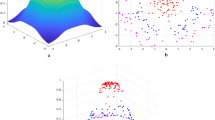Abstract
The main advantage of the kernel methods is the possibility of using linear models in a nonlinear subspace by an implicit transformation of patterns to a high-dimensional feature space without computing their images directly. An appropriately constructed kernel results in a model that fits well to the structure underlying data and doesn’t over-fit to the sample. Recent state-of-the-art kernel evaluation measures are examined in this paper and their application in kernel optimization is verified. Alternative evaluation measures that outperform presented methods are proposed.Optimization leveraging these measures results in parameters corresponding to the classifiers that achieve minimal error rate for RBF kernel.
Access this chapter
Tax calculation will be finalised at checkout
Purchases are for personal use only
Preview
Unable to display preview. Download preview PDF.
Similar content being viewed by others
References
Aizerman, A., Braverman, E.M., Rozoner, L.I.: Theoretical Foundations of the Potential Function Method in Pattern Recognition Learning. ARC 25, 821–837 (1964)
Burges, C.J.C.: A Tutorial on Support Vector Machines for Pattern Recognition. Data Mining and Knowledge Discovery 2(2), 121–167 (1998)
Chang, C.C., Lin, C.J.: LIBSVM: a library for Support Vector Machines (2001), http://www.csie.ntu.edu.tw/~cjlin/libsvm
Cristianini, N., Shawe-Taylor, J.: An Introduction to Support Vector Machines and Other Kernel-based Learning Methods. Cambridge University Press, Cambridge (2000)
Cristianini, N., Shawe-Taylor, J., Elisseeff, A., Kandola, J.: On Kernel-Target Alignment. In: Advances in Neural Information Processing Systems, vol. 14, pp. 367–373. MIT Press, Cambridge (2001)
Frank, A., Asuncion, A.: UCI Machine Learning Repository (2010), http://archive.ics.uci.edu/ml
Kandola, J., Shawe-Taylor, J., Cristianini, N.: On the Extensions of Kernel Alignment. Technical Report NC-TR-02-120, Neural Networks and Computational Learning Theory (2002)
Kandola, J., Shawe-Taylor, J., Cristianini, N.: Optimizing Kernel Alignment over Combinations of Kernels. Technical Report at Department of Computer Science, Royal Holloway, University of London, UK (2002)
Nguyen, C.H., Ho, T.B.: Kernel Matrix Evaluation. In: Veloso, M.M. (ed.) IJCAI, pp. 987–992 (2007)
Pothin, J.B., Richard, C.: Optimal Feature Representation For Kernel Machines Using Kenrel-Target Alignment Criterion. In: Proceedings of International Conference on Acoustics, Speech, and Signal Processing (2007)
Schölkopf, B., Smola, A.J.: Learning with Kernels: Support Vector Machines, Regularization, Optimization, and Beyond. MIT Press, Cambridge (2001)
Wang, J., Lu, H., Plataniotis, K.N., Lu, J.: Gaussian Kernel Optimization for Pattern Classification. Pattern Recognition 42(7), 1237–1247 (2009)
Xiong, H., Swamy, M.N.S., Ahmad, M.O.: Optimizing the Kernel in the Empirical Feature Space. IEEE Transactions on Neural Networks 2(16), 460–474 (2005)
Author information
Authors and Affiliations
Editor information
Editors and Affiliations
Rights and permissions
Copyright information
© 2011 Springer-Verlag Berlin Heidelberg
About this paper
Cite this paper
Chudzian, P. (2011). Radial Basis Function Kernel Optimization for Pattern Classification. In: Burduk, R., Kurzyński, M., Woźniak, M., Żołnierek, A. (eds) Computer Recognition Systems 4. Advances in Intelligent and Soft Computing, vol 95. Springer, Berlin, Heidelberg. https://doi.org/10.1007/978-3-642-20320-6_11
Download citation
DOI: https://doi.org/10.1007/978-3-642-20320-6_11
Publisher Name: Springer, Berlin, Heidelberg
Print ISBN: 978-3-642-20319-0
Online ISBN: 978-3-642-20320-6
eBook Packages: EngineeringEngineering (R0)




